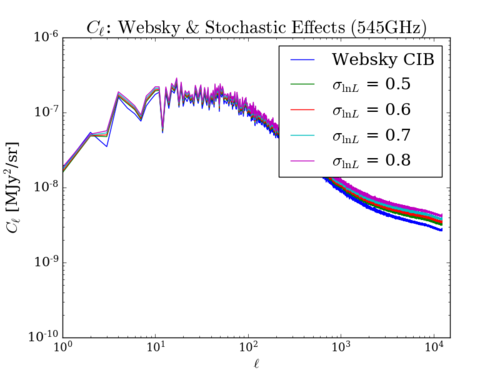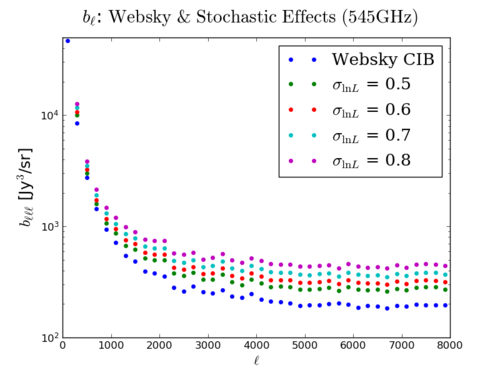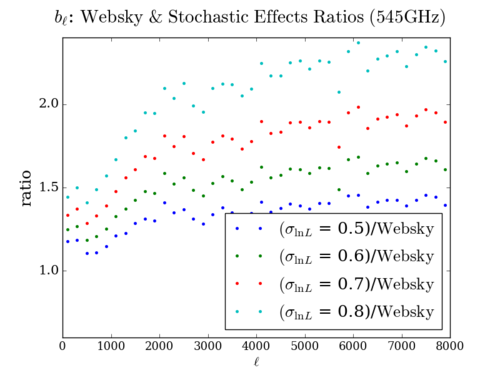Feb 7th, 2020 - Exploring the Stochasticity of Websky CIB Maps - I: Pixel-Level
Since we have been seeing some discrepancy between the Planck and Websky [math]\displaystyle{ b_{\ell\ell\ell} }[/math]'s, we decided to induce stochastic effects on the halo luminosities. In particular, Professor Bond mentioned that, "In the first instance we could say that all components of emission in the halo, central and satellite galaxies, could be enhanced / suppressed by one GRD (gaussian random deviate) rather than one GRD for each galaxy in the halo, since that would be a (crude) model for the nearby-perturber enhancement."
So I first revised a line in the 'halo2fluxmap' code (specifically the "makemaps.py" file):
intensity, flux_cen, flux_sat = h2fm.sources2map.sources2map(pcen,mcen,fcen,nsat,psat,msat,fsat,lcen,lsat) => intensity = h2fm.sources2map.sources2map(pcen,mcen,fcen,nsat,psat,msat,fsat,lcen,lsat)[0]*exp(sigma_lnL*GRD) flux_cen and flux_sat remaining the same for now
with the intensity being the intensity of each of the pixels (which I believe to be because the length of this array is the same as the number of pixels in an nside 4096 map), flux_cen being the flux values of the central galaxies, and flux_sat being the flux values of the satellite galaxies.
(The values of flux_cen and flux_sat do not seem to have an effect on the generated map at this point.)
So far, I have used the same set of GRD's and varied [math]\displaystyle{ \sigma_{\ln L} }[/math] by setting it to 0.5, 0.6, 0.7 and 0.8.
Below are the effects on the power spectrum and reduced bispectrum (in the equilateral, of course):
[math]\displaystyle{ C_{\ell} }[/math] (left) and [math]\displaystyle{ b_{\ell\ell\ell} }[/math] (right)

All the stochasiticity-induced maps have higher values of the 2-point and 3-point correlation statistics than the original Websky for all the values of [math]\displaystyle{ \sigma_{\ln L} }[/math] I have used so far, and the effect on the bispectrum looks larger.
To confirm this, I plotted the ratios of Stochasticity-Induced/Websky for both the power and bispectrum.
[math]\displaystyle{ C_{\ell} }[/math] (left) and [math]\displaystyle{ b_{\ell\ell\ell} }[/math] (right)

Here, we can certainly see that the ratios of the [math]\displaystyle{ b_{\ell\ell\ell} }[/math] is considerably larger than the ratios of the [math]\displaystyle{ C_{\ell} }[/math].
One thing I am planning to do is to set [math]\displaystyle{ \sigma_{\ln L} }[/math] a little lower than 0.5 (perhaps 0.3~0.4) and take a look at the power spectrum and bispectrum. Of course, this may simply result in both spectra to converge to Websky spectra, but it could turn out to be interesting (I still have not figured out how to calculate the exact value of [math]\displaystyle{ \sigma_{\ln L} }[/math] in 'halo2fluxmap').
The next thing to do would be to induce the stochasticity on actual halo or galaxy levels since what I have explored is stochasticity on a pixel-level, which is probably different from halo or galaxy levels as we noted when we were attempting to produce scrambled maps.
Side Note: I just had a thought; I could use a GRD to randomly increase or decrease the mass of each of the halos in the catalog, which would be substantially less complicated than trying to do this directly to luminosity.